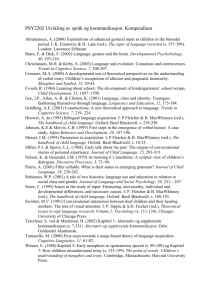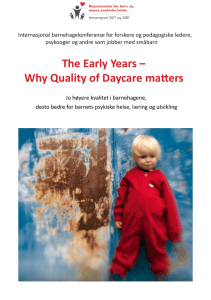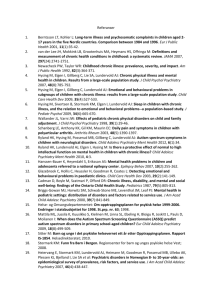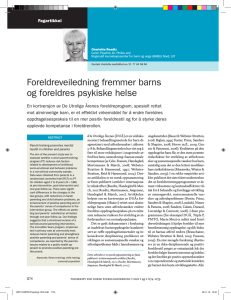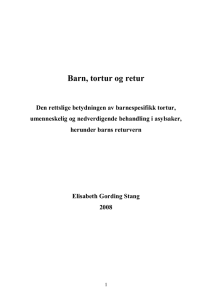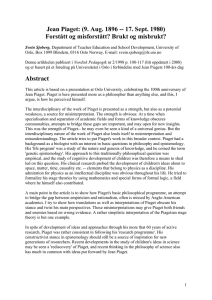PSY2202 pensum og tillegg
advertisement
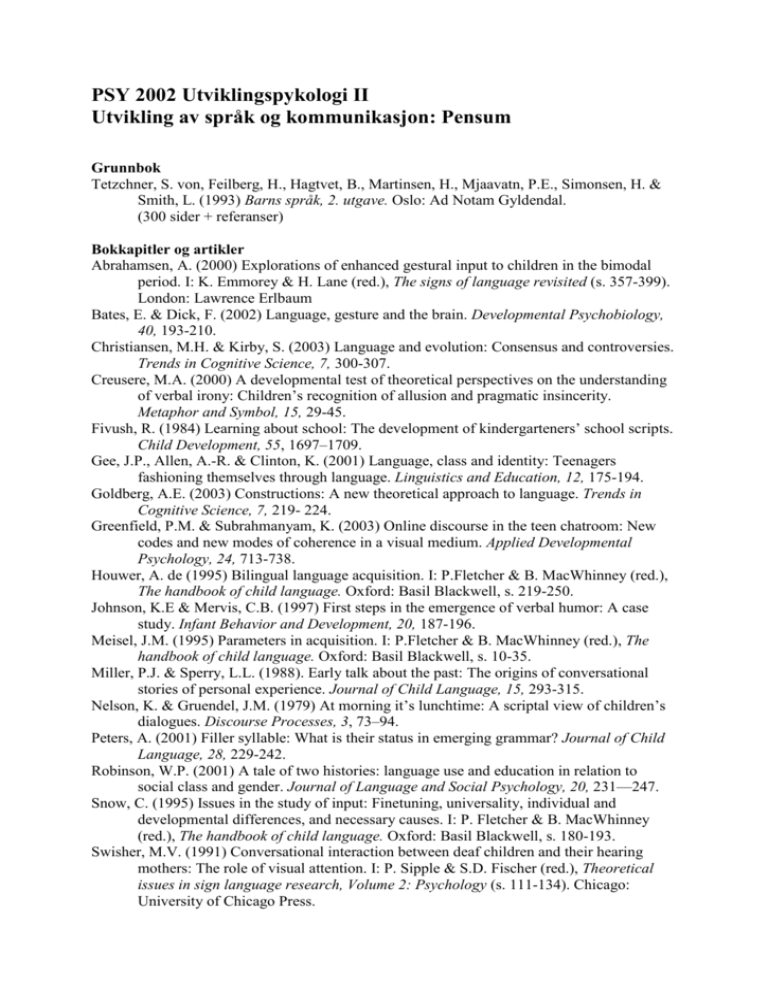
PSY 2002 Utviklingspykologi II Utvikling av språk og kommunikasjon: Pensum Grunnbok Tetzchner, S. von, Feilberg, H., Hagtvet, B., Martinsen, H., Mjaavatn, P.E., Simonsen, H. & Smith, L. (1993) Barns språk, 2. utgave. Oslo: Ad Notam Gyldendal. (300 sider + referanser) Bokkapitler og artikler Abrahamsen, A. (2000) Explorations of enhanced gestural input to children in the bimodal period. I: K. Emmorey & H. Lane (red.), The signs of language revisited (s. 357-399). London: Lawrence Erlbaum Bates, E. & Dick, F. (2002) Language, gesture and the brain. Developmental Psychobiology, 40, 193-210. Christiansen, M.H. & Kirby, S. (2003) Language and evolution: Consensus and controversies. Trends in Cognitive Science, 7, 300-307. Creusere, M.A. (2000) A developmental test of theoretical perspectives on the understanding of verbal irony: Children’s recognition of allusion and pragmatic insincerity. Metaphor and Symbol, 15, 29-45. Fivush, R. (1984) Learning about school: The development of kindergarteners’ school scripts. Child Development, 55, 1697–1709. Gee, J.P., Allen, A.-R. & Clinton, K. (2001) Language, class and identity: Teenagers fashioning themselves through language. Linguistics and Education, 12, 175-194. Goldberg, A.E. (2003) Constructions: A new theoretical approach to language. Trends in Cognitive Science, 7, 219- 224. Greenfield, P.M. & Subrahmanyam, K. (2003) Online discourse in the teen chatroom: New codes and new modes of coherence in a visual medium. Applied Developmental Psychology, 24, 713-738. Houwer, A. de (1995) Bilingual language acquisition. I: P.Fletcher & B. MacWhinney (red.), The handbook of child language. Oxford: Basil Blackwell, s. 219-250. Johnson, K.E & Mervis, C.B. (1997) First steps in the emergence of verbal humor: A case study. Infant Behavior and Development, 20, 187-196. Meisel, J.M. (1995) Parameters in acquisition. I: P.Fletcher & B. MacWhinney (red.), The handbook of child language. Oxford: Basil Blackwell, s. 10-35. Miller, P.J. & Sperry, L.L. (1988). Early talk about the past: The origins of conversational stories of personal experience. Journal of Child Language, 15, 293-315. Nelson, K. & Gruendel, J.M. (1979) At morning it’s lunchtime: A scriptal view of children’s dialogues. Discourse Processes, 3, 73–94. Peters, A. (2001) Filler syllable: What is their status in emerging grammar? Journal of Child Language, 28, 229-242. Robinson, W.P. (2001) A tale of two histories: language use and education in relation to social class and gender. Journal of Language and Social Psychology, 20, 231—247. Snow, C. (1995) Issues in the study of input: Finetuning, universality, individual and developmental differences, and necessary causes. I: P. Fletcher & B. MacWhinney (red.), The handbook of child language. Oxford: Basil Blackwell, s. 180-193. Swisher, M.V. (1991) Conversational interaction between deaf children and their hearing mothers: The role of visual attention. I: P. Sipple & S.D. Fischer (red.), Theoretical issues in sign language research, Volume 2: Psychology (s. 111-134). Chicago: University of Chicago Press. Tetzchner, S. von & Martinsen, H. (2002) Kapittel 1: Alternativ og supplerende kommunikasjon (s. 7-33) i Alternativ og supplerende kommunikasjon. Oslo: Gyldendal Akademisk. Tomasello, M. (2000) First steps towards a usage-based theory of language acquisition. Cognitive Linguistics, 11, 61-82. Winner, E. (1988) Kapittel 5: Early metaphors in spontaneous speech (s. 90-109) og Kapittel 7: How children misunderstand irony (s. 133-159). The point of words: Children’s understanding of metaphor and irony. Cambridge, Massachusetts: Harvard University Press. (Totalt om lag 380 sider + referanser). Støttelitteratur Grunnlag Tetzchner, S. von (2001) Kapittel 15: Utvikling av kommunikasjon og språk (s. 307-363) i Utviklingspsykologi. Oslo: Gyldendal Akademisk. Dette kapitlet har vært pensum for de som nylig har tatt psykologi grunnfag eller innføringskurset i utviklingspsykologi (PSY 2200). Det forutsettes derfor at studentene har lest dette kapitlet eller tilsvarende. Annen støttelitteratur Akhtar, N., Carpenter, M. & Tomasello, M. (1996) The role of discourse novelty in early word learning. Child Development, 67, 635–645. Bates, E., Devescovi, A. & Wulfeck, B. (2001) Psycholinguistics: A cross-language perspective. Annual Review of Psychology, 52, 369-396. Bloom, L. & Tinker, E. (2001) The intentionality model and language acquisition. Monographs of the Society for Research in Child Development, 66 (4), 1-91. Calvert, S.L., Mahler, B.A., Zehnder, S.M., Jenkins, A. & Lee, M.S. (2003) Gender differences in preadolescent children’s online interactions: Symbolic modes of selfpresentation and self-expression. Applied Developmental Psychology, 24, 627-644. Chomsky, N. (2000) New horizons in the study of language and mind. Cambridge: Cambridge University Press. Colston, H.L. & Kuiper, M.S. (2002) Figurative language development research and popular children’s literature, “Where the wild things are”. Metaphor and Symbol, 17, 27-43. Hickmann, M. (1998) Form function and context in narrative development. Journal of Pragmatics, 29, 33-56. Kimura, D. (1999) Kön och kognition. Studentlitteratur, 2001. Kintsch, W. & Bowles, A.R. (2002) Metaphor comprehension: What makes a metaphor difficult to understand? Metaphor and Symbol, 17, 249-262. Lindsay, G., Dockrell, J., Letchford, B. & Mackie, C. (2002) Self esteem of children with specific speech and language difficulties. Child Language Teaching and Therapy,18, 125-143. Marcus, G.F. & Fisher, S.E. (2003) FOXP2 in focus: What can genes tell us about speech and language? Trends in Cognitive Science, 7, 257-262. Gibbs, R.W. (2001) Evaluating cotemporary models of figurative language understanding. Metaphor and Symbol, 16, 317-333. Hall, D.G., Burns, T.C. & Pawluski, J.L. (2003) Input and word learning: Caregivers sensitivity to lexical category distinctions. Journal of Child Language, 30, 711-729. Martinsen, H., Nordeng, H. & Tetzchner, S. von (1985) Tegnspråk: Sosial betydning, utvikling og pedagogisk bruk. Oslo: Universitetsforlaget. Olmedo, I.M. (2003) Language mediation among emergent bilingual children. Linguistics and Education, 14, 143-162. Tetzchner, S. & Grove, N. (red.) (2003) Augmentative and alternative communication: Developmental issues. London, UK: Whurr. Tetzchner, S. von & Martinsen, H. (2002) Alternativ og supplerende kommunikasjon. Oslo: Gyldendal Akademisk. Tomasello, M. (2003) Constructing a language. A usage-based theory of language acquisition. London: Harvard University Press. Tomasello, M. & Barton, M. (1994) Learning words in nonostensive contexts. Developmental Psychology, 30, 639–650 Tomasello, M. & Farrar, M.J. (1986) Joint attention and early language. Child Development, 57, 1454–1463. Trevarthen, C. & Aitken, K.J. (2001) Infant intersubjectivity: Research, theory and clinical applications. Journal of Clinical Psychology and Psychiatry, 42, 3-48. Wells, G. (1986) Variation in child language. I: P. Fletcher og M. Garman (red.), Language acquisition, Second editon (s. 109–147). Cambridge: Cambridge University Press. Winner, E. (1988) The point of words: Children’s understanding of metaphor and irony. Cambridge, Massachusetts: Harvard University Press. Winsler, A., León, J.R. de, Wallace, B.A., Carlton, M.P & Willson-Quayle, A. (2003) Private speech in preschool children: Developmental stability and change, across-task consistency and relations with classroom behaviour. Journal of Child Language, 30, 583-608.
